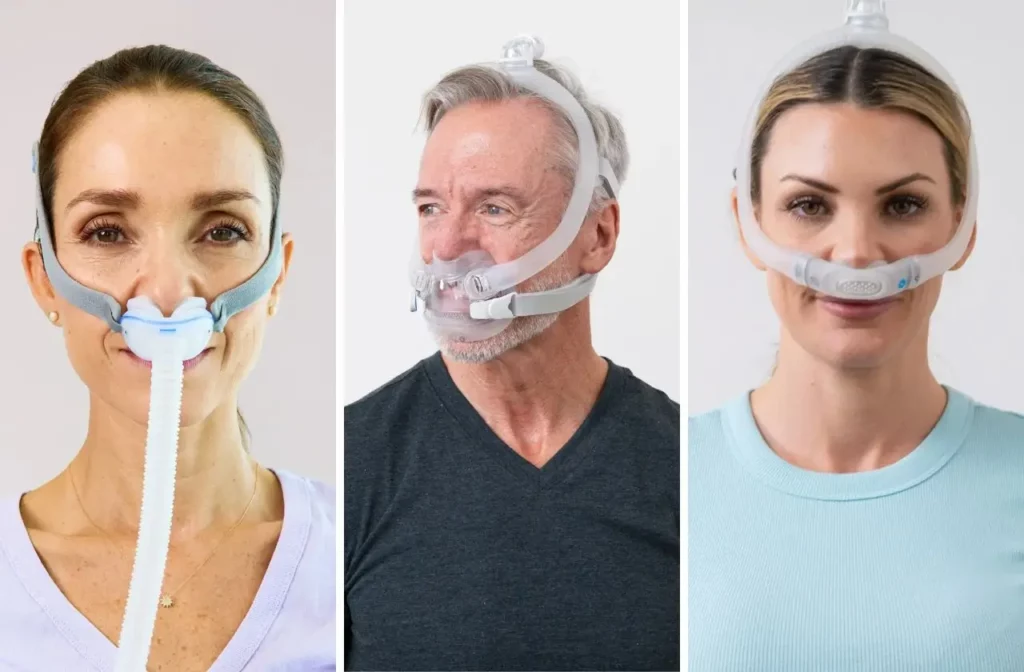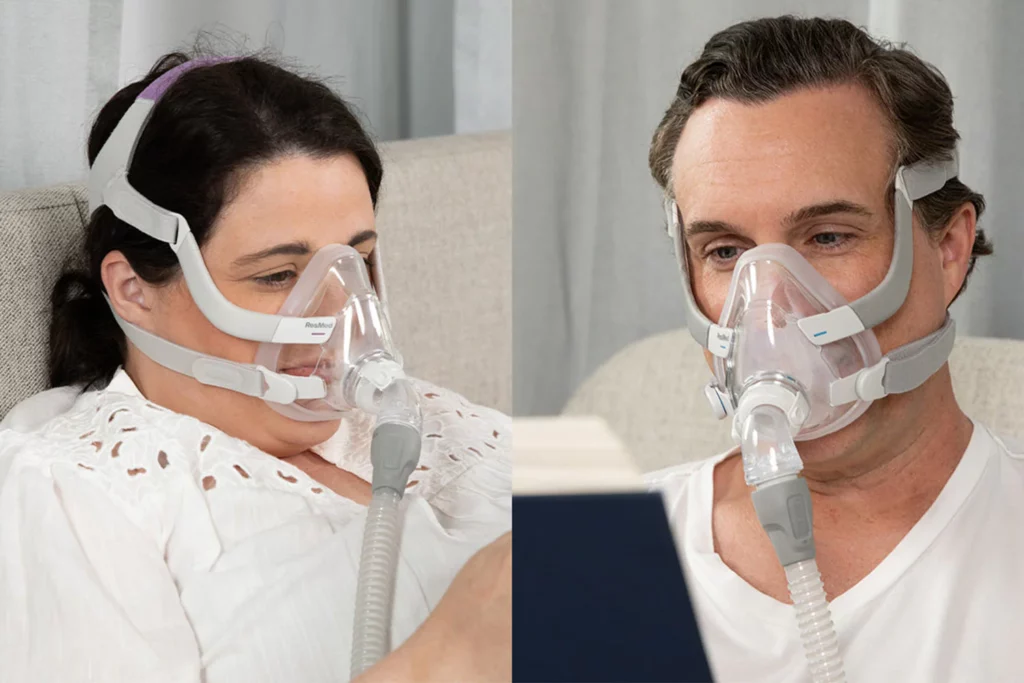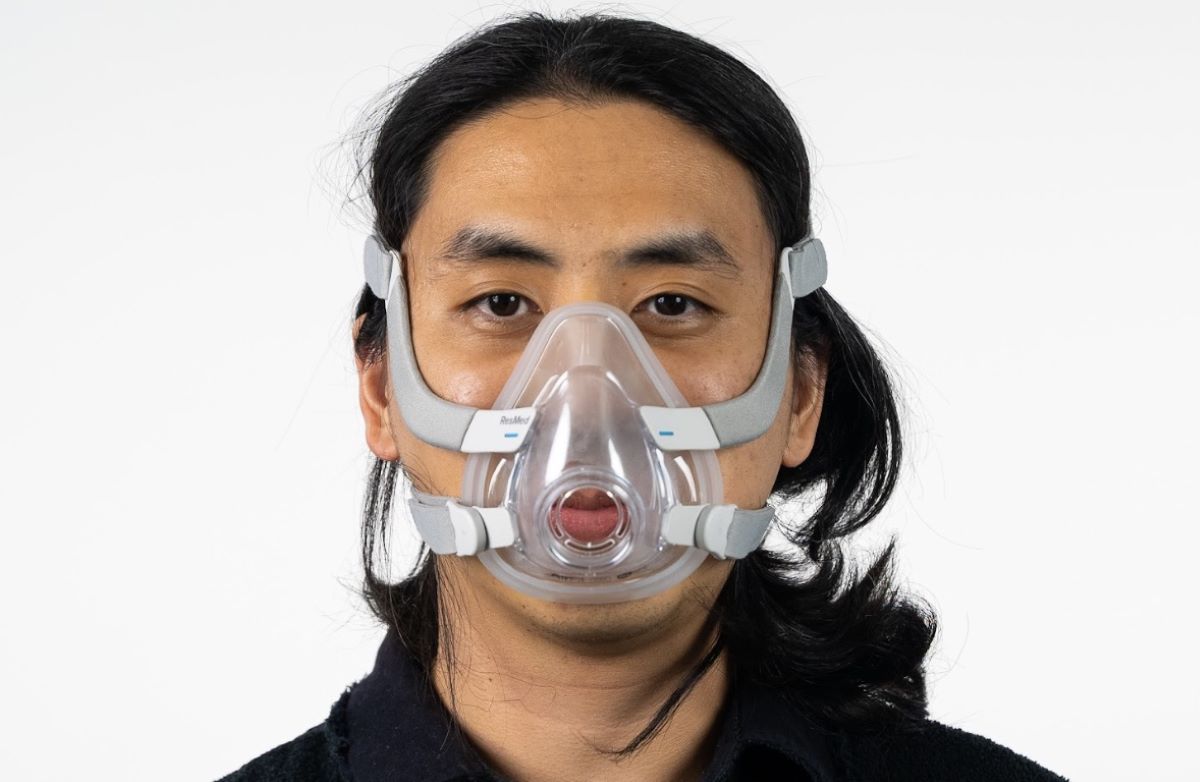What Is CPAP Therapy for Sleep Apnea and How Does It Work?
CPAP therapy is a medical treatment that uses a machine to deliver pressurised air through a mask, preventing the airway from collapsing during sleep. Sleep apnea occurs when throat muscles relax excessively, blocking the airway and causing breathing to stop repeatedly throughout the night.
These breathing interruptions fragment sleep and reduce oxygen levels in the blood. People with untreated sleep apnea often experience:
- Chronic daytime fatigue and drowsiness
- Morning headaches
- Difficulty concentrating
- Increased risk of cardiovascular problems
- Mood disturbances
The CPAP machine generates a steady stream of pressurised air that flows through a tube connected to a mask worn over the nose, mouth, or both. This continuous positive airway pressure acts as a pneumatic splint, keeping the upper airway open during sleep. The prescribed pressure level is calibrated specifically for each patient based on sleep study results.
When used consistently, CPAP therapy eliminates breathing pauses and restores normal sleep patterns. The treatment proves particularly effective for obstructive sleep apnea, the most common form of the condition. Choosing the Best CPAP Mask is essential for ensuring comfort, maintaining a secure seal, and achieving effective therapy—especially for side sleepers, who often face unique challenges with mask fit and air leakage.
What Are the Unique Challenges Faced by Side Sleepers Using CPAP Masks?
Side sleepers encounter specific obstacles that can compromise their CPAP therapy effectiveness. The primary issue stems from the pressure exerted by the pillow against the mask, which creates several complications during sleep.
1. Mask displacement
Mask displacement represents the most common problem for side sleepers. When the head rests on the pillow, the weight and angle push against the mask, causing it to shift out of position. This movement disrupts the seal between the mask and face, reducing therapy effectiveness throughout the night.
2. Air leakage
Air leakage occurs when the mask seal breaks due to pillow pressure. The escaping air creates noise, dries out the eyes, and reduces the therapeutic pressure needed to keep airways open. Many side sleepers wake multiple times per night to readjust their masks, fragmenting their sleep quality.
3. Pressure soreness
Pressure soreness develops on contact points where the mask presses harder against the face. Side sleepers experience concentrated pressure on one side of the face, leading to red marks, skin irritation, and discomfort. This soreness can discourage consistent CPAP use.
4. Limited movement
Limited movement restricts natural sleep positions. Bulkier masks prevent comfortable side sleeping, forcing users to choose between effective therapy and preferred sleeping positions. The tubing can also tangle or pull on the mask when changing positions, creating additional disruption to sleep.
What Are the Different Types of CPAP Masks Available for Side Sleepers?
Three primary CPAP mask types serve different needs and sleeping positions. Each design offers distinct advantages for side sleepers dealing with mask displacement and comfort issues.
1. Nasal Pillow Masks
Nasal Pillow Masks feature small cushions that rest directly at the nostrils rather than covering the entire nose. These lightweight masks create minimal facial contact, making them the most popular choice amongst side sleepers. The compact design sits higher on the nose than standard pillows, reducing the risk of displacement when your head presses against bedding.
2. Nasal Masks
Nasal Masks cover the entire nose with a cushioned seal held by headgear straps. These CPAP mask types offer more coverage than nasal pillows whilst remaining less bulky than full-face options. They work particularly well for side sleepers requiring higher pressure settings, as the broader seal distributes air pressure more evenly across the nose.
3. Full-Face Masks
Full-Face Masks encompass both the nose and mouth with a larger cushion and more substantial headgear. Whilst these masks appear less suitable for side sleeping due to their size, certain modern designs feature slimmer profiles that accommodate lateral sleeping positions. They become necessary for mouth breathers or individuals needing simultaneous nose and mouth coverage during therapy.
The right CPAP mask types depend on your breathing patterns, pressure requirements, and how much facial contact you can tolerate whilst sleeping on your side.
Why Are Nasal Pillow Masks Often Recommended as the Best Option for Side Sleepers?
Nasal pillow masks are often recommended as the best option for side sleepers due to their unique design. Unlike traditional masks that can be bulky and may shift out of place when pressing against a pillow, nasal pillow masks have a minimalist design that eliminates this issue.
How Nasal Pillow Masks Work
These masks feature small, soft cushions that seal directly at the nostrils rather than covering the entire nose. This design allows for a secure fit that stays in place regardless of sleeping position.
Benefits of Nasal Pillow Masks for Side Sleepers
The benefits of nasal pillow masks go beyond their compact profile. Here are some key advantages they offer specifically for side sleepers:
- Unobstructed field of vision – With no mask covering your eyes, you can comfortably read or watch television before sleep without any interference.
- Reduced claustrophobia – The minimal facial coverage of nasal pillow masks creates a less restrictive feeling, making them more comfortable for individuals who experience claustrophobia.
- Lower leak rates – The simple seal points of the mask mean there are fewer opportunities for air to escape during position changes, resulting in lower leak rates and better therapy effectiveness.
- Quieter operation – Since nasal pillow masks have less surface area compared to traditional masks, they produce less noise from air vents, allowing for a quieter sleep environment.
- Cooler sleep experience – The limited material used in nasal pillow masks prevents heat buildup around the face, providing a cooler and more comfortable sleeping experience.
How Nasal Pillow Masks Benefit Side Sleepers
Nasal pillow masks also offer specific benefits for side sleepers:
- Weighing significantly less than traditional masks reduces pressure points on the face and head, which is particularly valuable when lying on your side for extended periods.
- The lightweight construction means less material touching your skin, dramatically reducing the risk of pressure sores and facial marking that many CPAP users experience.
- The design positions the connection point higher on the face, allowing the tubing to route over the head rather than across the pillow. This prevents tangles and maintains consistent airflow throughout the night.
Overall, nasal pillow masks are often recommended as the best option for side sleepers due to their unique design features and specific benefits they offer in terms of comfort, effectiveness, and convenience during sleep therapy.

When Might Nasal Masks Be a Suitable Choice for Side Sleepers?
Nasal masks for side sleepers become the preferred option when therapy requires higher air pressure settings that nasal pillows cannot adequately deliver. These masks create a more secure seal around the entire nose, providing better stability for pressures above 12-15 cmH2O.
Side sleepers who experience nasal pillow discomfort may find nasal masks more tolerable. The cushion distributes pressure across a larger surface area rather than concentrating it at the nostrils, reducing the risk of nostril irritation or soreness during extended use.
Key situations favouring nasal masks include:
- Active sleepers who shift positions frequently throughout the night
- Users with narrow or sensitive nostrils that cannot accommodate pillow inserts
- Those experiencing claustrophobia with full-face designs but needing more coverage than pillows provide
- Individuals with deviated septums or nasal valve collapse requiring additional support
Modern nasal mask designs feature low-profile frames that sit away from the face, minimising bulk against the pillow. Many models incorporate flexible cushions that adapt to facial movements, maintaining seal integrity even when pressure from the pillow pushes against the mask. The headgear typically routes tubing over the head rather than across the face, allowing unrestricted side sleeping without hose interference.
Can Full-Face Masks Still Work Well for Side Sleepers?
Full-face masks side sleeping combinations can succeed when specific conditions align, despite these masks being bulkier than other options. Mouth breathers who cannot maintain a closed mouth during sleep require full-face coverage to prevent air leakage and maintain therapeutic pressure levels. Users prescribed higher pressure settings may also benefit from the stable seal these masks provide.
Certain full-face mask designs accommodate side sleeping better than others. Models with flexible frames and adjustable forehead supports distribute pressure more evenly when lying on one side. Masks featuring soft, gel-infused cushions conform to facial contours whilst minimising pressure points against the pillow.
Key scenarios where full-face masks work for side sleepers:
- Chronic nasal congestion or obstruction requiring mouth breathing
- Prescribed CPAP pressures exceeding 15 cm H₂O
- Previous unsuccessful attempts with nasal or pillow masks
- Facial hair preventing adequate seal with smaller mask types
- Claustrophobia triggered by masks covering only the nose
The mask’s cushion size plays a critical role in maintaining seal integrity during position changes. Smaller full-face masks with compact cushions reduce bulk against the pillow whilst still covering both airways. Selecting models with minimal facial contact points and low-profile designs helps prevent displacement when rolling from side to side throughout the night. Click here to get how often should you replace a CPAP mask and why it matters?
What Key Factors Should They Consider When Choosing a CPAP Mask for Side Sleeping?
Proper CPAP mask fit is the most critical factor for side sleepers. A mask that fits correctly prevents air leakage, reduces pressure sores, and stays in place throughout the night despite positional changes.
The cushion size directly impacts seal quality. Side sleepers need cushions that maintain contact with the face even when pressed against a pillow. Testing different cushion sizes—often available in small, medium, and large—helps identify which creates the most consistent seal during lateral sleeping positions.
Comfort factors extend beyond initial fit. The headgear design determines how well the mask stays positioned when the head turns. Adjustable straps should distribute pressure evenly without creating tight spots that dig into the skin. Masks with minimal facial coverage typically cause less discomfort for side sleepers who shift positions frequently.
Material quality affects long-term wearability. Soft silicone cushions conform better to facial contours and feel gentler against the skin than rigid materials. The mask’s weight matters too—lighter designs reduce the pulling sensation that occurs when lying on one side. Visit https://www.health.tas.gov.au/health-topics/burns/burns-care/care-facial-burns to get about caring for facial burns.
Compatibility with existing CPAP equipment requires verification. Not all masks connect to every machine model, and checking specifications before purchase prevents costly mistakes. The mask’s pressure rating must match or exceed the prescribed therapy settings to function properly during treatment.
Additionally, it’s essential to consider safety guidelines while using CPAP machines, especially in terms of hygiene and maintenance of equipment, to ensure optimal performance and longevity of both the mask and machine.
How Can Users Maintain Their CPAP Mask to Improve Comfort and Seal?
Proper CPAP mask maintenance directly prevents air leaks and pressure sores that commonly affect side sleepers. Daily cleaning removes facial oils, dead skin cells, and bacteria that degrade cushion materials and compromise the seal against your pillow. To further enhance the effectiveness of your CPAP therapy, consider following this comprehensive guide on maximizing CPAP efficacy through proper care and maintenance.
Daily Cleaning Routine:
- Wipe mask cushions and frame with unscented baby wipes or CPAP-specific wipes each morning
- Wash cushions, headgear, and frame weekly in warm water with mild, fragrance-free soap
- Rinse thoroughly and air-dry completely away from direct sunlight
- Never use harsh chemicals, alcohol, or bleach that deteriorate silicone materials
Component Replacement Schedule:
Side sleepers experience accelerated wear due to increased friction against pillows. Replace cushions every 1-2 months when you notice visible wear, permanent creasing, or declining seal quality. Headgear stretches over time and requires replacement every 3-6 months to maintain proper tension. Full mask frames typically last 6-12 months before the materials become brittle or cracked.
Critical Maintenance Tips:
Inspect your mask before each use for cracks, tears, or hardened cushions. Store your mask in a clean, dry location away from pets and dust. Hand-wash only—dishwashers and washing machines damage delicate components. Keep replacement parts on hand since worn cushions cause immediate seal failure during side sleeping positions.

Are There Any Additional Accessories That Can Help Side Sleepers Use Their CPAP Masks More Effectively?
Specialised CPAP pillows represent one of the most effective accessories for side sleepers struggling with mask stability. These pillows feature contoured cutouts that accommodate the mask and tubing, preventing compression against the pillow surface that typically causes leaks and discomfort.
The ergonomic design supports proper cervical spine alignment whilst creating space for the mask to rest undisturbed. This dual benefit addresses both therapeutic effectiveness and physical comfort during extended sleep periods.
Chin straps offer another practical solution, particularly for mouth breathers using nasal pillow or nasal masks. These straps gently hold the jaw closed, preventing air from escaping through the mouth and maintaining consistent therapy pressure throughout the night.
Tubing management systems help keep hoses positioned away from the sleeping area, reducing the risk of tangling or pulling on the mask during position changes. Some users find that mask liners made from soft fabric reduce facial irritation and absorb moisture, creating a more comfortable barrier between skin and silicone cushions.
When considering what is the best CPAP mask for side sleepers, pairing the right mask with appropriate accessories maximises therapy success and sleep quality.
FAQs-Best CPAP Mask for Side Sleepers
CPAP therapy delivers continuous pressurised air through a mask to prevent airway collapse during sleep, treating obstructive sleep apnea and restoring normal breathing patterns.
2. How Does CPAP Therapy Work?
A CPAP machine produces a steady stream of air that travels through tubing into a mask worn over the nose or mouth. This pressure keeps the airway open, preventing breathing interruptions.
3. Why Is CPAP Therapy Important for Sleep Apnea Treatment?
Consistent CPAP use prevents oxygen drops, improves sleep quality, reduces fatigue, and lowers the risk of heart disease, high blood pressure, and other complications linked to untreated OSA.
4. What Challenges Do Side Sleepers Face When Using CPAP Masks?
Side sleepers often struggle with mask displacement, air leaks, and pressure soreness due to pillow contact, which can reduce therapy effectiveness and disrupt sleep quality.
5. What Types of CPAP Masks Are Best for Side Sleepers?
Side sleepers typically benefit from nasal pillow masks or low-profile nasal masks that stay secure during movement and reduce air leaks caused by pillow pressure.
6. Why Are Nasal Pillow Masks Ideal for Side Sleepers?
Nasal pillow masks are lightweight, reduce facial pressure, stay in place during side sleeping, and provide an open field of vision—making them the most comfortable and effective option.
7. Can Full-Face Masks Work for Side Sleepers?
Yes, certain compact full-face masks with soft cushions and flexible frames can suit side sleepers who breathe through their mouths or need higher pressure settings.
8. How Can Side Sleepers Maintain Their CPAP Mask for Better Comfort and Seal?
Daily cleaning with mild soap, weekly washing of components, and timely replacement of cushions (every 1–2 months) help maintain comfort, hygiene, and a strong seal.
9. What Accessories Help Side Sleepers Use CPAP Masks More Effectively?
Special CPAP pillows, chin straps, tubing holders, and mask liners prevent leaks, reduce irritation, and improve stability for a comfortable night’s sleep.

